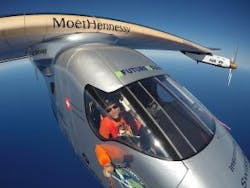It’s a Bird! It’s a Plane! It’s a Microgrid! Solar Impulse 2 Completes US Flight
Bertrand Piccard, Solar Impulse chairman. COPYRIGHT: Solar Impulse
In a kind of ‘one-giant-leap-for-mankind’ moment, the Solar Impulse 2 landed in New York City Saturday, completing its flight across the U.S.
The flying microgrid is on a quest to circle the globe. If it succeeds, Solar Impulse will be the first plane fueled only by the sun to make it 24,855-miles around the world.
Landing at JFK Airport at almost 4 a.m. (Yes, it can fly in the dark.), the ABB-backed plane did a Statue of Liberty flyby, a gesture to their mutual symbolism. Both are tributes to freedom, one for democracy the other energy independence.
Using no fossil fuels, the Solar Impulse derives its energy from 17,000 solar photovoltaic panels built into the wings. They are backed by four 38.5 kWh batteries. The energy powers four high-efficiency motors by way of a sophisticated control system. By day the flying microgrid uses solar energy, by night the batteries.
The New York stopover marked the 14th leg of the plane’s journey, this one from Lehigh Valley, Pennsylvania, a 165-mile flight taken at an average speed of 35 mph and a maximum altitude of 3,000 feet.
Earlier U.S. stops included Silicon Valley, Phoenix, Tulsa and Dayton. The plane heads next to Europe.
Update! Since this article was written, the Solar Impulse completed its journey across the Atlantic, landing in Spain, and finishing 90 percent of its round-the-world journey.
Microgrids are typically stationary, mini versions of the larger electric grid, and more likely to be found serving communities, universities, hospitals or business parks than a plane in flight. However, the Solar Impulse is not the only movable microgrid. Modern-day ships are often described as sea-faring microgrids, given that their on-site energy sources can power the ship independently, and the ship can connect or disconnect from the main grid at port.
More than 12 years of R&D have gone into the flying microgrid. The work has been led by Swiss engineers: Bertrand Piccard, initiator and chairman, as well as a medical doctor, and André Borschberg, co-founder and CEO, and an engineer. The pair take turns piloting the plane.
Watch the Solar Impulse 2 on YouTube as it flies to New York City.
Piccard, who also conceived the project as way to show the capability of renewable energy in powering contemporary society.
“All the technologies developed with our partners, such as electrical motors with 97 percent efficiency, LED lamps for public/private lightening system, extremely efficient insulation foam that can reduce energy consumption for houses, light materials, high energy density batteries and ultra-thin solar cells, can be used on the ground to contribute to a cleaner and more sustainable world,” said Piccard who also achieved the first non-stop, round-the-world, balloon flight.
The plane hasn’t experienced smooth flying all the way. Its worldwide journey began over a year ago in Abu Dubai, but by July the plane was grounded because of battery issues. It resumed the world-wide trek in April 2016. Solar Impulse also had to remained grounded in Pennsylvania for a few days longer than planned because of bad weather.
In addition to ABB, the main sponsors for Solar Impulse are Solvay, Omega and Schindler. Its official partners are Google, Altran, Covestro, Swiss Re Corporate Solutions, Swisscom and Moët Hennessy.
Do you subscribe to the free MicrogridKnowledge newsletter? Sign up today!
About the Author
Elisa Wood
Editor-in-Chief
Elisa Wood is the editor and founder of EnergyChangemakers.com. She is co-founder and former editor of Microgrid Knowledge.
